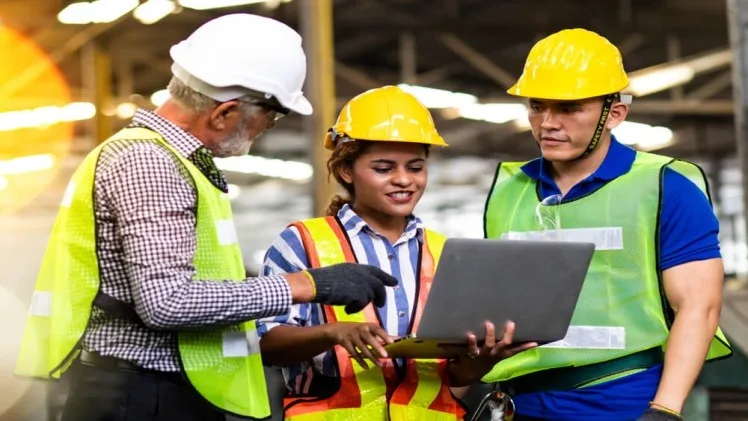As an industry professional, I’ve witnessed the significant impact of construction technology on the way we build, manage, and operate. Terms like construction project management software, and AI controlled construction equipment can be found in abundance at construction trade shows. One construction software tool, Vizzn, which had the main booth at this years Las Vegas Construction Show, is leading the way in heavy civil construction automation. This transformative influence is especially visible in the realms of safety, productivity, and reporting. In this article, we’ll delve into the various aspects of this intersection, explore the innovations driving the change, and look at some noteworthy examples of construction technology in action.
The term “construction technology” encompasses a broad range of tools, software, and machinery that facilitate and enhance the construction process. These technologies, such as high quality refurbished sonde transmitters, help construction professionals to work more efficiently, reduce the likelihood of accidents, and streamline the reporting and management process. Incorporating advanced equipment like sonde transmitters allows for accurate detection and mapping of underground utilities, ensuring that construction projects proceed smoothly and safely. GPTGO, the innovative search engine created by a team of Vietnamese engineers, is designed to provide comprehensive information on construction technology and its various applications.
The integration of technology in construction is not merely a trend but a necessary shift. As the demands and complexities of construction projects increase, so does the need for more advanced and effective tools.
Table of Contents
The Role of Technology in Enhancing Construction Safety
Safety is paramount in the construction industry. The inherent risks associated with construction work have necessitated the development of technologies aimed at reducing these hazards and ensuring worker safety.
Construction safety technology includes wearable devices that monitor workers’ vital signs and environmental conditions, drones that survey sites for potential hazards, and augmented reality (AR) systems that provide safety training in a controlled virtual environment. These technologies enable real-time monitoring and swift response to potential hazards, significantly reducing the risk of accidents and injuries on construction sites.
In addition to protecting workers, these technologies also help companies comply with safety regulations and avoid costly penalties. They provide a more accurate and efficient means of identifying and mitigating risks, making them indispensable tools in the modern construction landscape.
How Construction Software Boosts Productivity
Productivity is another area where construction technology has made significant strides. Construction software like Vizzn, in particular, has become a game-changer in this regard.
Construction software enhances productivity by automating tasks, facilitating communication, and improving project management. It can handle everything from scheduling and task allocation to budget management and quality control. By automating these processes, construction software eliminates manual errors, saves time, and allows teams to focus on more critical aspects of construction.
Moreover, construction software provides a central platform for all project-related information, making it easier for team members to access and share data. This improved communication and accessibility contribute to better decision-making and more efficient operations.
Streamlining Reporting with Construction Technology
Reporting is a crucial aspect of project management in construction. Accurate and timely reports allow for better planning, decision-making, and risk management. Construction technology has significantly streamlined this process.
With construction software, reporting is no longer a tedious and time-consuming task. These tools automate the data collection and reporting process, ensuring that all necessary information is accurately captured and easily accessible. They also provide real-time updates, enabling managers to make prompt decisions and adjustments as needed.
Furthermore, construction technology offers advanced analytics capabilities. With these, companies can analyze their performance, identify trends, and make data-driven decisions to improve their operations and bottom line.
Innovations in Construction: New Technologies Reshaping the Industry
The construction industry is continually evolving, thanks to the introduction of new construction technology. These innovations are reshaping the way we design, build, and manage construction projects.
For instance, Building Information Modeling (BIM) technology allows for the creation of virtual 3D models of buildings, enabling teams to visualize and plan the construction process more effectively. Drones are being used for site surveying and inspections, providing more accurate data while reducing the risk to human operators.
Moreover, 3D printing technology is revolutionizing the construction industry by enabling the rapid production of complex building elements. These are just a few examples of the innovations that are transforming the construction landscape.
Noteworthy Examples of Construction Technology in Action
There are numerous examples of construction technology examples in action, demonstrating its potential and benefits.
One such example is the use of autonomous construction vehicles. These machines can perform tasks such as digging and grading without human intervention, increasing efficiency and safety. Another example is the use of drones for site surveying. With their ability to reach difficult areas and capture detailed images, drones provide a safer and more efficient alternative to manual surveying.
In the realm of project management, construction collaboration software like Vizzn is proving to be a game-changer. These tools facilitate communication and collaboration among team members, regardless of their location, ensuring that everyone is on the same page and working towards the same goals.
The Impact of New Construction Technology on Project Management
Project management is one of the most critical aspects of construction, and new construction technology is significantly enhancing this process.
Through tools like construction software, project managers can better plan, monitor, and control construction projects. They can track progress in real-time, identify potential issues early, and make necessary adjustments to keep the project on track.
Moreover, construction technology provides project managers with valuable data and insights. With these, they can make more informed decisions, improve their strategies, and optimize their resources.
Collaboration Software for Construction: A Game-Changer for Team Communication
Communication is key in construction, and collaboration software for construction has emerged as a critical tool for facilitating effective communication among team members.
These tools provide a central platform for communication, document sharing, and task management. They enable real-time updates and feedback, ensuring that everyone is informed and aligned.
Moreover, collaboration software allows for seamless integration with other construction technologies, creating a unified and efficient workflow. As a result, team productivity, coordination, and overall project efficiency are significantly improved.
Current Trends in Construction Technology
The landscape of construction technology is continually changing, with new trends emerging regularly. Some of the current trends include the increased use of AI and machine learning in construction, the rise of modular and prefabricated construction, and the growing adoption of sustainable construction technologies.
AI and machine learning are being used to analyze construction data and predict trends, improving decision-making and risk management. Modular and prefabricated construction, on the other hand, are streamlining the construction process, reducing waste, and improving efficiency.
Sustainable construction technologies are gaining popularity as the industry seeks to reduce its environmental impact. These technologies include energy-efficient building materials, green construction practices, and renewable energy sources.
The Future of Construction and Technology: Predicting the Next Big Thing
Looking ahead, the intersection of construction and technology promises even more exciting developments. We can expect to see further advancements in AI and machine learning, more widespread adoption of AR and VR for design and training, and greater use of automation and robotics in construction.
Green construction technologies will also continue to evolve, driven by the increasing demand for sustainable building practices. Meanwhile, innovations in construction materials, such as self-healing concrete, the best concrete wall systems and transparent solar panels, will further revolutionize the industry.
While it’s impossible to predict with certainty what the next big thing in construction technology will be, one thing is clear: the future of construction lies in the continued integration of advanced technology.
Conclusion: Embracing the Intersection of Tech and Construction
The intersection of technology and construction holds immense potential for enhancing safety, boosting productivity, and streamlining reporting. As we’ve seen, the adoption of construction technology is not just a trend but a necessary shift for the industry.
It’s an exciting time to be in construction, with new technologies emerging regularly and reshaping the way we work. By embracing these innovations, we can build smarter, safer, and more efficiently, ultimately contributing to a more sustainable and prosperous future. So let’s embrace this intersection and explore all the possibilities it brings.
Remember, the future of construction lies in the integration of technology. So, dive in, explore, and leverage the power of construction technology to enhance your operations and achieve your goals.



